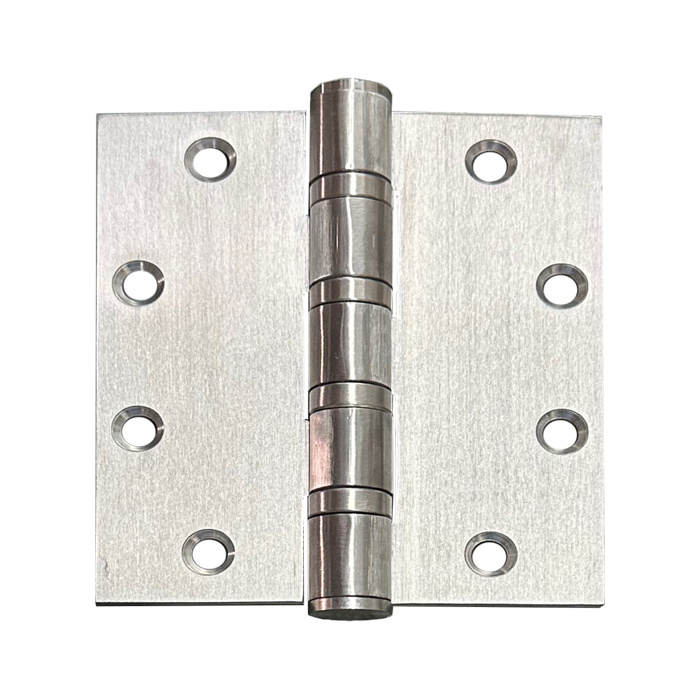Heavy Duty Stainless Hinges: Features That Make a Difference for Durability and Performance
2025-08-18

Heavy Duty Stainless Hinges: Features That Make a Difference
Introduction to Heavy Duty Stainless Hinges
In the world of hardware and fittings, **heavy-duty stainless hinges** stand out for their exceptional strength and corrosion resistance. These hinges are designed to support heavy doors and equipment while maintaining smooth functionality even in the most demanding environments. In this article, we delve into the distinctive features that make heavy-duty stainless hinges a superior choice for various applications, from residential to industrial.
Understanding the Composition of Heavy Duty Stainless Hinges
The Importance of Stainless Steel in Hinges
Stainless steel is an alloy primarily composed of iron, chromium, and other elements that provide remarkable resistance to rust and corrosion. The inclusion of chromium gives stainless steel its stainless quality, making it ideal for heavy-duty applications where exposure to moisture and harsh conditions is common.
Types of Stainless Steel Used in Heavy Duty Hinges
1. **304 Stainless Steel**: Known for its excellent corrosion resistance and overall durability, this type is commonly used in general applications.
2. **316 Stainless Steel**: Offers superior corrosion resistance, particularly in marine environments, making it ideal for coastal areas or industries dealing with harsh chemicals.
3. **430 Stainless Steel**: A less expensive option, providing decent corrosion resistance but is not as strong as 304 or 316 grades.
Key Features of Heavy Duty Stainless Hinges
1. Load-Bearing Capacity
One of the standout features of heavy-duty stainless hinges is their impressive load-bearing capacity. Designed to support significant weight, these hinges are perfect for heavy doors, gates, and other applications where strength is crucial. Depending on the design and size, some heavy-duty stainless hinges can support weights exceeding 500 pounds.
2. Corrosion Resistance
Due to their stainless steel composition, these hinges exhibit exceptional resistance to rust and corrosion, extending their lifespan significantly compared to standard hinges. This feature is particularly important in environments with high humidity or exposure to chemicals, where traditional hinges may fail prematurely.
3. Versatile Design Options
Heavy-duty stainless hinges come in various designs, including butt hinges, continuous hinges, and strap hinges, making them versatile for different applications. This variety allows users to choose the perfect hinge type that fits their specific needs.
4. Smooth Operation
The precision engineering of heavy-duty stainless hinges ensures a smooth operation, which is vital for user comfort and convenience. Unlike lower-quality hinges that may squeak or bind, these hinges are designed to operate quietly and effortlessly.
5. Aesthetic Appeal
While functionality is paramount, aesthetic considerations are also important. Heavy-duty stainless hinges offer a sleek, polished finish that can enhance the overall appearance of doors and equipment, making them an attractive option for both commercial and residential applications.
Applications of Heavy Duty Stainless Hinges
1. Industrial and Commercial Use
In industrial settings, heavy-duty stainless hinges are commonly used on heavy doors, machinery access panels, and storage containers. Their ability to withstand harsh conditions makes them a reliable choice for factories, warehouses, and manufacturing plants.
2. Residential Applications
Homeowners increasingly favor heavy-duty stainless hinges for exterior doors, garage doors, and gates. Their durability and corrosion resistance ensure that these critical components function well for years.
3. Marine and Coastal Environments
For boats, docks, and coastal buildings, 316 stainless steel hinges are often the go-to choice due to their exceptional resistance to saltwater corrosion. The longevity of these hinges can significantly reduce maintenance costs in marine applications.
4. Healthcare Facilities
In hospitals and clinics, hygiene is paramount. Heavy-duty stainless hinges are often used on doors in these settings, as they can withstand frequent cleaning and disinfecting without deteriorating.
How to Choose the Right Heavy Duty Stainless Hinges
1. Assess Load Requirements
Before selecting hinges, it is crucial to determine the weight of the door or equipment they will support. Understanding load requirements will guide your decision in choosing the appropriate hinge size and type.
2. Consider Environmental Factors
Evaluate the environment where the hinges will be installed. For humid or corrosive environments, opt for 316 stainless steel to ensure optimal performance and longevity.
3. Select the Right Design
Choose a hinge design that aligns with your specific application. Butt hinges are ideal for traditional doors, while continuous hinges offer enhanced stability for wider doors.
4. Look for Quality Standards
Ensure that the hinges meet industry quality standards. Look for certifications or ratings that indicate they are tested for durability and performance.
Maintenance Tips for Heavy Duty Stainless Hinges
To maximize the lifespan and functionality of heavy-duty stainless hinges, consider the following maintenance practices:
1. Regular Cleaning
Periodically clean the hinges with a damp cloth to remove dust, dirt, and debris. For stubborn grime, a mild detergent can help restore their shine without damaging the finish.
2. Lubrication
Applying a lubricant specifically designed for stainless steel hinges can enhance their smooth operation and prevent wear over time. Make sure to avoid lubricants that attract dirt and grime.
3. Inspect for Wear and Tear
Regularly inspect hinges for signs of wear, rust, or damage. Early detection of any issues can prevent more significant problems down the line.
4. Replace When Necessary
If a hinge shows significant signs of deterioration, it's crucial to replace it promptly to ensure the continued safety and functionality of the door or equipment.
Frequently Asked Questions (FAQs)
1. What makes heavy-duty stainless hinges different from standard hinges?
Heavy-duty stainless hinges are designed to support heavier loads and provide greater durability and corrosion resistance than standard hinges.
2. Are heavy-duty stainless hinges suitable for outdoor use?
Yes, heavy-duty stainless hinges are ideal for outdoor use, especially those made from 316 stainless steel, which offers excellent corrosion resistance.
3. How do I know which size hinge to choose?
To determine the right size, consider the weight of the door or equipment and consult the manufacturer’s load capacity specifications for the hinges.
4. Can heavy-duty stainless hinges be painted?
While it is possible to paint stainless steel, it is generally not recommended, as it may compromise the hinge's performance and appearance. If aesthetics are a concern, consider hinges with a finish that matches your design needs.
5. What is the typical lifespan of heavy-duty stainless hinges?
The lifespan can vary based on usage and environmental factors, but high-quality heavy-duty stainless hinges can last for many years, often exceeding 10 years or more with proper maintenance.
Conclusion
Heavy-duty stainless hinges are an invaluable component in various applications, providing unmatched durability, corrosion resistance, and aesthetic appeal. Understanding their unique features and benefits allows you to make informed decisions for your projects, whether in industrial, commercial, or residential settings. By selecting the right type, maintaining them properly, and staying aware of their specifications, you can ensure these hinges perform optimally for years to come. Investing in high-quality heavy-duty stainless hinges ultimately pays off in terms of safety, efficiency, and longevity.
PREVIOUS:
Contact Us
E-mail :
ivyhinge@163.com
Phone/WhatsApp:
+86 18924942354
Address:
XIAOLAN TOWN,ZHONGSHAN cIty,GUANGDONG province,China



